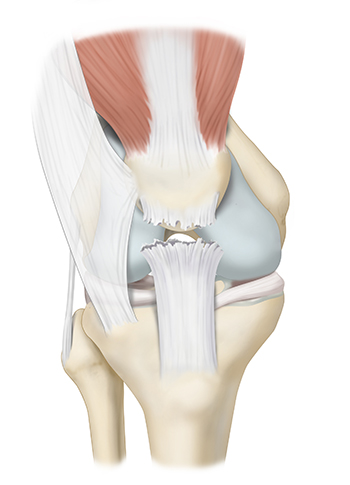Patellar Tendon Injuries
The knee joint is supported by several important tendons, which play a crucial role in stabilizing and facilitating the movement of the knee. The patellar tendon connects the patella (kneecap) to the tibia (shinbone). It plays a central role in straightening the knee and is essential for activities like standing, walking, and running.
The patellar tendon is part of a larger biomechanical structure called the knee extensor mechanism. The knee extensor mechanism is comprised of the patellar tendon, quadriceps tendon, quadriceps muscle group, and the patella. Together, these anatomical structures work to facilitate extension (straightening) of the knee and stability to the knee joint.
A patellar tendon rupture is characterized by a complete or partial full thickness tear of the patellar tendon. The patellar tendon is a strong, flat band of tissue connecting the patella to the tibial tuberosity, which is a bony prominence of the tibia. The patellar tendon transmits forces generated by the quadriceps muscles to the tibia, which allows for knee extension. Thus, in cases of patellar tendon ruptures, patients’ ability to extend the leg, walk, run, or jump will likely be compromised.

Patellar tendon ruptures are typically caused by a sudden, powerful contraction of the quadriceps muscle in your thigh. This can happen from a fall or during activities like jumping, landing, or sudden stops. Chronic overuse and degenerative changes can also contribute to patellar tendon injury, especially in older individuals.
- Severe pain in the front of the knee, typically below or around the kneecap.
- Swelling of the knee
- Inability to straighten your knee/perform a straight leg raise.
- Inability to bear weight on the leg.
- A noticeable gap or divot just below the kneecap
- Possible migration of the patella upwards.
A combination of a comprehensive physical examination, x-rays, and an MRI are typically needed to accurately diagnose a patellar tendon injury. Dr. Jorge Chahla and his team will perform a physical exam that will include palpating your knee for a tendon gap/divot, testing your ability to perform a straight leg raise, and assessing your range of motion. An x-ray will likely be obtained to rule out fracture and determine if the patella has migrated proximally, a condition known as patella alta. An MRI will allow Dr. Chahla to further evaluate the extent of the tendon injury as well as to evaluate the knee for any concomitant ligament, meniscal, or cartilage injuries.
Patellar tendon injuries can range from mild inflammation (patellar tendinitis) to complete tendon ruptures, leading to significant pain and difficulty extending the knee. These injuries are common in athletes and individuals who engage in repetitive jumping or running activities. Dr. Jorge Chahla specializes in diagnosing and treating patellar tendon injuries, offering both conservative and surgical solutions. If you have sustained a patellar tendon injury, schedule an appointment with Dr. Chahla in Chicago, Naperville, or Oak Brook for expert care.
At a Glance
Dr. Jorge Chahla
- Triple fellowship-trained sports medicine surgeon
- Performs over 800 surgeries per year
- Associate professor of orthopedic surgery at Rush University
- Learn more

